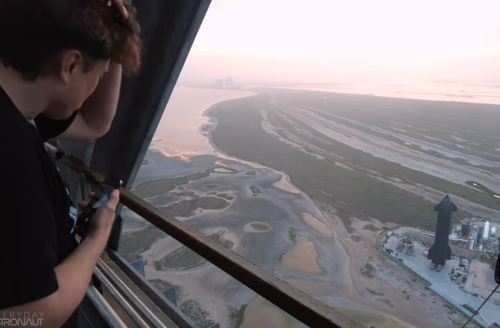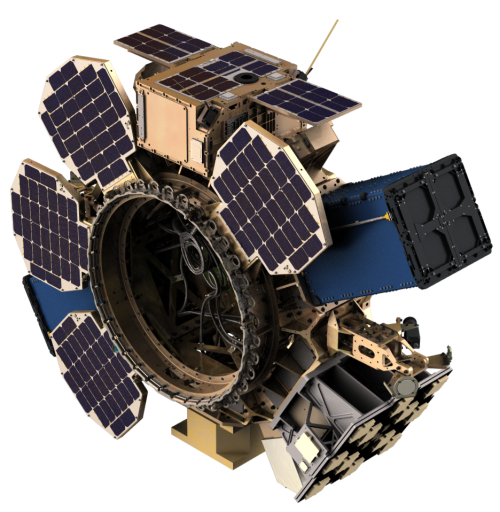Author: Robert Zimmerman
On the radio…
UPDATE: The show started late due to technical problems, but is going on now!
I will be doing another long guest appearance tonight on The Space Show with David Livingston, beginning at 7 pm (Pacific). You can listen live here. (link fixed, though now it doesn’t matter as the show just ended. It will be archived and available in a day or so.)
As always, I strongly encourage my readers to call in. Makes the show more fun.
UPDATE: The show started late due to technical problems, but is going on now!
I will be doing another long guest appearance tonight on The Space Show with David Livingston, beginning at 7 pm (Pacific). You can listen live here. (link fixed, though now it doesn’t matter as the show just ended. It will be archived and available in a day or so.)
As always, I strongly encourage my readers to call in. Makes the show more fun.
Pushback: HOA demands flag be removed; Neighbors rally and raise their own flags

Free speech banned by Cumberland Crossing HOA.
Bring a gun to a knife fight: When the Cumberland Crossing HOA in Ohio demanded that resident Thomas DiSario take down the thin blue line flag he had been flying for five years to honor his son — who had been a policeman killed in the line of duty — he not only refused, all his neighbors rallied in support by raising their own flags throughout the neighborhood.
Some neighbors in a subdivision near Etna are making a statement after a resident was told to take down his “thin blue line flag” by the Homeowner’s Association. The HOA told him to remove it, calling it a political statement.
“I applaud them for it and it’s growing. You see more flags out every few days, you see a few more flags and blue light bulbs,” said Kathy Riddle, neighbor.
More and more neighbors in Cumberland Crossing are mounting thin blue line flags outside their homes. “We wanted to show respect for our neighbor. And we appreciate the service that his family member gave,” said Riddle.
It appears that the HOA demanded the flag’s removal after one complaint, and claimed the reason for doing so was simply because “It is a political statement.” The image below shows the text from the HOA letter, clearly indicating that its reasons for demanding the flag’s removal was an attempt by the HOA to ban political speech.
» Read more

Free speech banned by Cumberland Crossing HOA.
Bring a gun to a knife fight: When the Cumberland Crossing HOA in Ohio demanded that resident Thomas DiSario take down the thin blue line flag he had been flying for five years to honor his son — who had been a policeman killed in the line of duty — he not only refused, all his neighbors rallied in support by raising their own flags throughout the neighborhood.
Some neighbors in a subdivision near Etna are making a statement after a resident was told to take down his “thin blue line flag” by the Homeowner’s Association. The HOA told him to remove it, calling it a political statement.
“I applaud them for it and it’s growing. You see more flags out every few days, you see a few more flags and blue light bulbs,” said Kathy Riddle, neighbor.
More and more neighbors in Cumberland Crossing are mounting thin blue line flags outside their homes. “We wanted to show respect for our neighbor. And we appreciate the service that his family member gave,” said Riddle.
It appears that the HOA demanded the flag’s removal after one complaint, and claimed the reason for doing so was simply because “It is a political statement.” The image below shows the text from the HOA letter, clearly indicating that its reasons for demanding the flag’s removal was an attempt by the HOA to ban political speech.
» Read more
Astronomers discover pulsar with slowest rotation rate of any known neutron star
The uncertainty of science: Using the MeerKAT radio telescope in South Africa, astronomers have discovered a pulsar with the slowest rotation rate of any known neutron star, completing each rotation every 76 seconds.
According to the press release:
Neutron stars are extremely dense remnants of supernova explosions of massive stars. Scientists know of about 3,000 of these in our Galaxy. However, the new discovery is unlike anything seen so far. The team think it could belong to the theorised class of ultra-long period magnetars – stars with extremely strong magnetic fields.
From the paper’s abstract:
With a spin period of 75.88 s, a characteristic age of 5.3 Myr and a narrow pulse duty cycle, it is uncertain how its radio emission is generated and challenges our current understanding of how these systems evolve. The radio emission has unique spectro-temporal properties, such as quasi-periodicity and partial nulling, that provide important clues to the emission mechanism. Detecting similar sources is observationally challenging, which implies a larger undetected population. Our discovery establishes the existence of ultra-long-period neutron stars, suggesting a possible connection to the evolution of highly magnetized neutron stars, ultra-long-period magnetars and fast radio bursts.
Essentially, a pulsar with this length rotation was not expected, and its existence throws a wrench into present theories about their formation and evolution. That its existence might provide a link between neutron stars, magnetars, and the as-yet unexplained fast radio bursts, however, is very intriguing.
The uncertainty of science: Using the MeerKAT radio telescope in South Africa, astronomers have discovered a pulsar with the slowest rotation rate of any known neutron star, completing each rotation every 76 seconds.
According to the press release:
Neutron stars are extremely dense remnants of supernova explosions of massive stars. Scientists know of about 3,000 of these in our Galaxy. However, the new discovery is unlike anything seen so far. The team think it could belong to the theorised class of ultra-long period magnetars – stars with extremely strong magnetic fields.
From the paper’s abstract:
With a spin period of 75.88 s, a characteristic age of 5.3 Myr and a narrow pulse duty cycle, it is uncertain how its radio emission is generated and challenges our current understanding of how these systems evolve. The radio emission has unique spectro-temporal properties, such as quasi-periodicity and partial nulling, that provide important clues to the emission mechanism. Detecting similar sources is observationally challenging, which implies a larger undetected population. Our discovery establishes the existence of ultra-long-period neutron stars, suggesting a possible connection to the evolution of highly magnetized neutron stars, ultra-long-period magnetars and fast radio bursts.
Essentially, a pulsar with this length rotation was not expected, and its existence throws a wrench into present theories about their formation and evolution. That its existence might provide a link between neutron stars, magnetars, and the as-yet unexplained fast radio bursts, however, is very intriguing.
Rogozin: Russia’s first lunar lander in decades to launch by end of September

The new colonial movement: Dmitry Rogozin, the head of Russia’s Roscosmos space corporation, revealed yesterday that it is now targeting the end of September for the launch of Luna-25, the first Russian lunar lander to the Moon since Luna-24 in 1976.
The Russians hope to land the rover near 60-mile-wide Boguslawsky crater, located about 550 miles from the Moon’s south pole. The map to the right, figure 1 from a 2018 paper, provides the reasoning for picking this location.
The Luna–Glob mission [the title for the entire Russian program of future lunar probes] is designed for investigations in the polar regions of the Moon and targeted primarily on testing a new generation of technologies for landing a descent module. In this regard, the choice of scientific tasks of this mission is rather subordinate. Further realization of our lunar program, inclusive of the Luna–Resource mission with an extended complex of scientific tasks, and subsequently, a new generation of lunar rovers and modules for lunar subsurface sampling and return to the Earth, depends on the results of the present mission [Luna-25]. …The detailed photo geological analysis of the surface in the Luna–Glob mission landing sector (70°–85° S, 0°–60° E) using high-resolution images and topographic data made it possible to select the definite landing site. This site (the eastern landing ellipse, 73.9° S, 43.9° E) on the Boguslawsky floor represents a higher scientific priority and also provides relatively safe landing conditions.
The Russians have been attempting to launch this Luna-Glob program for almost a quarter of a century. Hopefully the first launch will finally happen this year.

The new colonial movement: Dmitry Rogozin, the head of Russia’s Roscosmos space corporation, revealed yesterday that it is now targeting the end of September for the launch of Luna-25, the first Russian lunar lander to the Moon since Luna-24 in 1976.
The Russians hope to land the rover near 60-mile-wide Boguslawsky crater, located about 550 miles from the Moon’s south pole. The map to the right, figure 1 from a 2018 paper, provides the reasoning for picking this location.
The Luna–Glob mission [the title for the entire Russian program of future lunar probes] is designed for investigations in the polar regions of the Moon and targeted primarily on testing a new generation of technologies for landing a descent module. In this regard, the choice of scientific tasks of this mission is rather subordinate. Further realization of our lunar program, inclusive of the Luna–Resource mission with an extended complex of scientific tasks, and subsequently, a new generation of lunar rovers and modules for lunar subsurface sampling and return to the Earth, depends on the results of the present mission [Luna-25]. …The detailed photo geological analysis of the surface in the Luna–Glob mission landing sector (70°–85° S, 0°–60° E) using high-resolution images and topographic data made it possible to select the definite landing site. This site (the eastern landing ellipse, 73.9° S, 43.9° E) on the Boguslawsky floor represents a higher scientific priority and also provides relatively safe landing conditions.
The Russians have been attempting to launch this Luna-Glob program for almost a quarter of a century. Hopefully the first launch will finally happen this year.
FAA once again delays approval for launching Starship from Boca Chica
Capitalism in space: The FAA today announced that it is once again delaying release of its environmental reassessment of SpaceX’s Boca Chica facility in Texas, setting a new release date only two weeks hence.
The FAA intended to release the Final PEA on May 31, 2022. The FAA now plans to release the Final PEA on June 13, 2022 to account for ongoing interagency consultations. A notice will be sent to individuals and organizations on the project distribution list when the Final PEA is available.
The previous five delays had each been month-long. This two week delay strongly suggests that the bureaucrats are getting close to a final agreement. Whether that means SpaceX will receive an approval, which is what the initial draft had suggested back in December, or be blocked, we shall have to see. A statement SpaceX CEO Gwynne Shotwell in mid-May that the company would be ready to launch Starship by June suggests it will be an approval.
I have been predicting since December that the month-by-month delays would continue until after the November election. I will be quite happy if that prediction ends up wrong.
Capitalism in space: The FAA today announced that it is once again delaying release of its environmental reassessment of SpaceX’s Boca Chica facility in Texas, setting a new release date only two weeks hence.
The FAA intended to release the Final PEA on May 31, 2022. The FAA now plans to release the Final PEA on June 13, 2022 to account for ongoing interagency consultations. A notice will be sent to individuals and organizations on the project distribution list when the Final PEA is available.
The previous five delays had each been month-long. This two week delay strongly suggests that the bureaucrats are getting close to a final agreement. Whether that means SpaceX will receive an approval, which is what the initial draft had suggested back in December, or be blocked, we shall have to see. A statement SpaceX CEO Gwynne Shotwell in mid-May that the company would be ready to launch Starship by June suggests it will be an approval.
I have been predicting since December that the month-by-month delays would continue until after the November election. I will be quite happy if that prediction ends up wrong.
Freedom Toons – Jordan Peterson sings Evanescence
An evening pause: I don’t know why, but to me this cartoon, which puts the fundamental words of Jordan Peterson to the tune of a rock song, with appropriate but light-hearted visuals, seems perfect for this year’s Memorial Day. From the song:
You cannot escape the suffering that comes with life
Carry all your pain
Become hero archetype
The past generations who sacrificed their lives for our civilization, whom we are supposed to honor and remember today, understood these words and didn’t need a teacher to explain them. Today’s generation, badly taught by my 60s generation, needs to hear them and think about them. If they do, the future will be bright indeed.
Hat tip Geoffrey Carman.
Today’s blacklisted American: College punishes student for telling others about her religious exemption from COVID jab

Free speech voided at Oakland University
They’re coming for you next: The Oakland University (OU), a public college in Michigan, has punished student Inara Ramazanova because she had the nerve to describe to others how she had gotten a religious exemption from its mandate that all students get COVID shots or be banned from campus.
From the warning letter [pdf] sent to the university by her lawyers, the First Liberty Institute:
Last summer, OU granted Ms. Ramazanova a religious accommodation from the university’s COVID-19 vaccine mandate. The accommodation would have allowed her to reside on campus for the 2021–22 academic year.
However, OU evicted Ms. Ramazanova after it deemed her protected, religious speech, which Ms. Ramazanova intended to aid others in the exercise of their rights, to be “collusion or conspiracy” under the OU’s Code of Conduct for sharing about COVID-19 religious accommodations in a private Facebook group. OU’s decision forced Ms. Ramazanova to spend her final semester at OU living at home and attending classes online while participating in OU-required weekly COVID-19 testing on campus.
» Read more

Free speech voided at Oakland University
They’re coming for you next: The Oakland University (OU), a public college in Michigan, has punished student Inara Ramazanova because she had the nerve to describe to others how she had gotten a religious exemption from its mandate that all students get COVID shots or be banned from campus.
From the warning letter [pdf] sent to the university by her lawyers, the First Liberty Institute:
Last summer, OU granted Ms. Ramazanova a religious accommodation from the university’s COVID-19 vaccine mandate. The accommodation would have allowed her to reside on campus for the 2021–22 academic year.
However, OU evicted Ms. Ramazanova after it deemed her protected, religious speech, which Ms. Ramazanova intended to aid others in the exercise of their rights, to be “collusion or conspiracy” under the OU’s Code of Conduct for sharing about COVID-19 religious accommodations in a private Facebook group. OU’s decision forced Ms. Ramazanova to spend her final semester at OU living at home and attending classes online while participating in OU-required weekly COVID-19 testing on campus.
» Read more
The new satellite industry, energized by freedom

Liberty enlightening the world, both on it and in space.
Last week SpaceX successfully completed its 22nd launch in 2022, sending 59 smallsats into orbit with its Falcon 9 rocket.
In the past few decades, the launch of a smallsat would generally have not merited much further coverage. These satellites, almost always based on the 10-centimeter (or 4-inch) square cubesat design, had generally been short term objects built almost always by university students not so much to do space research as to simply learn how to build satellites and learn how they operated in orbit.
This has now all changed, fueled both by the immense drop in launch costs generated by the competition between the new rockets built by SpaceX and the new emerging smallsat rocket companies (Rocket Lab, Virgin Orbit, and Astra) and by the improved capabilities of miniaturized components. Cubesats can now do far more despite being tiny, and they can be launched for much less money.
The result has been wonderfully illustrated by the satellites launched last week on that Falcon 9. Below is a short list of the press releases in the past few days, announcing the successful activation of these satellites:
» Read more
Boeing picks company to manufacture flight suits for passengers on Starliner

ILC Dover’s spacesuits.
Capitalism in space: On May 26th ILC Dover announced it has been chosen by Boeing as one of two companies to manufacture flight suits for passengers on Starliner.
The Boeing AES [Ascent/Entry Suit] is based off ILC Dover’s commercial Launch, Entry, and Abort suit, SOL™. ILC Dover worked with Boeing to tailor SOL for the Starliner spacecraft to provide protection for astronauts during the most critical phases of spaceflight, including launch, docking, re-entry and landing. With over 50 years of spacesuit experience, the AES suit was designed to provide maximum mobility to operate, enter and exit the spacecraft, as well as provide protection for astronauts in case of an emergency.
The black spacesuit on the left in the picture is Dover’s SOL suit, which it is adapting for Boeing. The white suit is the spacewalk suit it has made for NASA for use on ISS, which I also think is the same spacesuit that has for now almost a decade had repeated problems with water leaking into the helmet.
In other words, big space Boeing has hired another big space company to build its Starliner flight suits. I hope ILC Dover does a better job with the AES suit then it has with its EVA suit.

ILC Dover’s spacesuits.
Capitalism in space: On May 26th ILC Dover announced it has been chosen by Boeing as one of two companies to manufacture flight suits for passengers on Starliner.
The Boeing AES [Ascent/Entry Suit] is based off ILC Dover’s commercial Launch, Entry, and Abort suit, SOL™. ILC Dover worked with Boeing to tailor SOL for the Starliner spacecraft to provide protection for astronauts during the most critical phases of spaceflight, including launch, docking, re-entry and landing. With over 50 years of spacesuit experience, the AES suit was designed to provide maximum mobility to operate, enter and exit the spacecraft, as well as provide protection for astronauts in case of an emergency.
The black spacesuit on the left in the picture is Dover’s SOL suit, which it is adapting for Boeing. The white suit is the spacewalk suit it has made for NASA for use on ISS, which I also think is the same spacesuit that has for now almost a decade had repeated problems with water leaking into the helmet.
In other words, big space Boeing has hired another big space company to build its Starliner flight suits. I hope ILC Dover does a better job with the AES suit then it has with its EVA suit.
Egypt to create a “space city” for space research and development
The new colonial movement: Mohamed al-Qousy, the head of Egypt’s space agency, announced yesterday that by the end of this year it will open a 123-acre site devoted to space research and commercial space business.
Qousy explained that the space city will contain 23 buildings to serve space activities, including a space academy, a research center, a center for the assembly of satellites, and a museum in the form of tourism in addition to the African Space Agency.
The agency aims to develop and transfer space science and technology into Egypt to build satellites and launch them from Egyptian territories.
It is not clear how much of this facility will be government-run, or privately owned. It appears most will be run by the government.
The new colonial movement: Mohamed al-Qousy, the head of Egypt’s space agency, announced yesterday that by the end of this year it will open a 123-acre site devoted to space research and commercial space business.
Qousy explained that the space city will contain 23 buildings to serve space activities, including a space academy, a research center, a center for the assembly of satellites, and a museum in the form of tourism in addition to the African Space Agency.
The agency aims to develop and transfer space science and technology into Egypt to build satellites and launch them from Egyptian territories.
It is not clear how much of this facility will be government-run, or privately owned. It appears most will be run by the government.
India’s press: End the endless launch delays at ISRO
The new colonial movement: An op-ed yesterday in one of India’s major news outlets demanded that its space agency ISRO end the launch delays that have now gone for more than two years since the beginning of the Wuhan panic, and get a number of military satellites into orbit.
The details are not really that important. What this op-ed suggests is that India’s press, and possibly its public, is now beginning to lose patience with ISRO’S reluctance to resume launches. It also suggests their own fear of the Wuhan flu has subsided.
The bottom line is that India has lost a lot of business in the past two years by its refusal to launch, especially in the smallsat market, and the only chance it has to regain that business is to resume launches, with a vengence.
The new colonial movement: An op-ed yesterday in one of India’s major news outlets demanded that its space agency ISRO end the launch delays that have now gone for more than two years since the beginning of the Wuhan panic, and get a number of military satellites into orbit.
The details are not really that important. What this op-ed suggests is that India’s press, and possibly its public, is now beginning to lose patience with ISRO’S reluctance to resume launches. It also suggests their own fear of the Wuhan flu has subsided.
The bottom line is that India has lost a lot of business in the past two years by its refusal to launch, especially in the smallsat market, and the only chance it has to regain that business is to resume launches, with a vengence.
China begins preparing Long March 5B for launch of next space station module
The new colonial movement: The Long March 5B rocket that will launch in July the next large module for China’s Tiangong space station, dubbed Wentian, has arrived at the launch site.
China’s Long March-5B Y3 rocket, which will launch lab module Wentian for the country’s space station, arrived on Sunday at the launch site in the southern island province of Hainan. The rocket, along with the Wentian lab module already transported to the Wenchang Spacecraft Launch Site, will be assembled and tested at the launch site, announced the China Manned Space Agency. [emphasis mine]
In all past launches of the Long March-5B the core first stage has crashed to Earth in an uncontrolled manner because its engine could not be restarted after it shut down. The highlighted “Y3” added to the rocket’s name above suggests China might have fixed this. Previous Long March-5B rockets used YF-77 engines. Adding Y3 to the name — which generally follows China’s system for naming its engines — could mean they will now be able to control the core stage’s de-orbit. This speculation is further strengthened by a previous report that China was testing a new engine for the core stage that implied it was restartable.
If so, China will avoid the kind of bad press it received with previous Long March 5B launches. It will also put it back in compliance with the Outer Space Treaty, which it violated with each past core stage crash.
The new colonial movement: The Long March 5B rocket that will launch in July the next large module for China’s Tiangong space station, dubbed Wentian, has arrived at the launch site.
China’s Long March-5B Y3 rocket, which will launch lab module Wentian for the country’s space station, arrived on Sunday at the launch site in the southern island province of Hainan. The rocket, along with the Wentian lab module already transported to the Wenchang Spacecraft Launch Site, will be assembled and tested at the launch site, announced the China Manned Space Agency. [emphasis mine]
In all past launches of the Long March-5B the core first stage has crashed to Earth in an uncontrolled manner because its engine could not be restarted after it shut down. The highlighted “Y3” added to the rocket’s name above suggests China might have fixed this. Previous Long March-5B rockets used YF-77 engines. Adding Y3 to the name — which generally follows China’s system for naming its engines — could mean they will now be able to control the core stage’s de-orbit. This speculation is further strengthened by a previous report that China was testing a new engine for the core stage that implied it was restartable.
If so, China will avoid the kind of bad press it received with previous Long March 5B launches. It will also put it back in compliance with the Outer Space Treaty, which it violated with each past core stage crash.
Environmentalists sue local Boca Chica officials for closing beaches for SpaceX
Muskhate: The Sierra Club and other environmental groups have now sued a variety of local Boca Chica government agencies for periodically closing the beaches during hazardous SpaceX operations.
The Sierra Club, the Carrizo/Comecrudo Tribe of Texas and non-profit Save RGV have joined together in a lawsuit against the Texas General Land Office, Texas land commissioner George P. Bush and Cameron County in Texas for closing Boca Chica Beach periodically for SpaceX operations during Starship tests, the Sierra Club stated May 5. The Boca Chica beach is near SpaceX’s Starbase facility, where it is building Starship rocket prototypes and their massive Super Heavy boosters.
“Restricting access to a public beach, as the defendants have done, violates the Texas constitution,” the Sierra Club said in a statement. None of the allegations have been proven in court, and the statement does not name SpaceX among the entities pursued in the lawsuit.
These are the same groups that have been lobbying government officials for the past few years to shut SpaceX down. They claim that a change to the state’s laws allowing these closures that was passed in 2013 violates the state’s constitution, and want the courts to agree.
Of course, we all know these organizations really have no interest in keeping the beaches open for public use. What they really want is to shut down SpaceX in Boca Chica, because that company is actually doing something exciting and innovative while bringing billions of investment capital to the Rio Grand Valley, including tens of thousands of new jobs. (The group called “Save RGV” is especially ironic and dishonest, since RGV stands for Rio Grand Valley. If their effort succeeded, they would not save RGV, but destroy it. All those jobs and billions would vanish, leaving the area as depressed and as poor as it has been now for decades.)
These groups also wish to destroy Elon Musk, because he has recently made it clear that he no longer is a knee-jerk supporter of all leftist causes.
Nor will their effort cease should they lose this case in court. They will do what environmental groups have done now for decades, find another minor legal issue and sue again, and again, and again, and again.
Muskhate: The Sierra Club and other environmental groups have now sued a variety of local Boca Chica government agencies for periodically closing the beaches during hazardous SpaceX operations.
The Sierra Club, the Carrizo/Comecrudo Tribe of Texas and non-profit Save RGV have joined together in a lawsuit against the Texas General Land Office, Texas land commissioner George P. Bush and Cameron County in Texas for closing Boca Chica Beach periodically for SpaceX operations during Starship tests, the Sierra Club stated May 5. The Boca Chica beach is near SpaceX’s Starbase facility, where it is building Starship rocket prototypes and their massive Super Heavy boosters.
“Restricting access to a public beach, as the defendants have done, violates the Texas constitution,” the Sierra Club said in a statement. None of the allegations have been proven in court, and the statement does not name SpaceX among the entities pursued in the lawsuit.
These are the same groups that have been lobbying government officials for the past few years to shut SpaceX down. They claim that a change to the state’s laws allowing these closures that was passed in 2013 violates the state’s constitution, and want the courts to agree.
Of course, we all know these organizations really have no interest in keeping the beaches open for public use. What they really want is to shut down SpaceX in Boca Chica, because that company is actually doing something exciting and innovative while bringing billions of investment capital to the Rio Grand Valley, including tens of thousands of new jobs. (The group called “Save RGV” is especially ironic and dishonest, since RGV stands for Rio Grand Valley. If their effort succeeded, they would not save RGV, but destroy it. All those jobs and billions would vanish, leaving the area as depressed and as poor as it has been now for decades.)
These groups also wish to destroy Elon Musk, because he has recently made it clear that he no longer is a knee-jerk supporter of all leftist causes.
Nor will their effort cease should they lose this case in court. They will do what environmental groups have done now for decades, find another minor legal issue and sue again, and again, and again, and again.
MAVEN out of operation since February
The American Mars orbiter MAVEN has been unable to do any science observations since February 22, 2022 because its attitude control system has not been functioning properly, according to a NASA update only released on May 18th, almost two months later.
In the weeks that followed, NASA managed to revive MAVEN from safe mode, but in a limited capacity. The orbiter is in a stable orbit with its primary antenna pointed at Earth to maintain high-rate communications with its flight control team. “In this configuration, however, MAVEN cannot perform communications relays for other spacecraft on Mars and is performing only limited science observations,” NASA officials wrote in the update (opens in new tab). “The mission team began science instrument recovery on April 20.” The orbiter normally serves as a communication relay for NASA’s Curiosity rover and Perseverance rover on Mars to beam the latest images and research from the Martian surface to Earth.
Though it can still do its own observations, MAVEN’s main task at this time is to act as a communications relay for the rovers on Mars. This issue prevents that task.
The American Mars orbiter MAVEN has been unable to do any science observations since February 22, 2022 because its attitude control system has not been functioning properly, according to a NASA update only released on May 18th, almost two months later.
In the weeks that followed, NASA managed to revive MAVEN from safe mode, but in a limited capacity. The orbiter is in a stable orbit with its primary antenna pointed at Earth to maintain high-rate communications with its flight control team. “In this configuration, however, MAVEN cannot perform communications relays for other spacecraft on Mars and is performing only limited science observations,” NASA officials wrote in the update (opens in new tab). “The mission team began science instrument recovery on April 20.” The orbiter normally serves as a communication relay for NASA’s Curiosity rover and Perseverance rover on Mars to beam the latest images and research from the Martian surface to Earth.
Though it can still do its own observations, MAVEN’s main task at this time is to act as a communications relay for the rovers on Mars. This issue prevents that task.
Flaky Martian rock
Cool image time! The photo to the right, reduced and enhanced to post here, was taken on May 15, 2022 (sol 3474) by the high resolution camera on the Mars rover Curiosity, and shows a rock that was near the rover at that time that I estimate to be around three to four feet long.
This picture was taken the same day Curiosity also took a panorama and close-up images of a row of teeth-like boulders that sat a short distance in front of the rover. Those rocks, much larger than the one to the right, had numerous large flakes protruding from their sides.
This smaller rock has even more such flakes, all much smaller and clearly more delicate.
The overview map to the right shows Curiosity’s present position with the blue dot. The yellow dot marks where it was when it took this photograph. The red dotted line shows the rover’s original planned route. The white arrows indicate what the scientists have dubbed the “marker horizon,” a distinct layer found in many places on the flanks of Mount Sharp that they are very eager to study up close.
The green dot marks the approximate location of a recurring slope lineae, a place where the cliff is seasonally darkened by a streak that appears each spring and then fades.
The two orange dotted lines are my guesses for the two possible routes the rover will take from here to get back to its planned route, abandoned in mid-April when the Greenheugh Pediment was found too rough for Curiosity’s wheels. Though science team has not published a new route, the direction traveled in recent weeks suggests these are the possibilities. If I had to choose, I would favor the east route, as it bypasses more completely the pediment with its rough terrain.
Cool image time! The photo to the right, reduced and enhanced to post here, was taken on May 15, 2022 (sol 3474) by the high resolution camera on the Mars rover Curiosity, and shows a rock that was near the rover at that time that I estimate to be around three to four feet long.
This picture was taken the same day Curiosity also took a panorama and close-up images of a row of teeth-like boulders that sat a short distance in front of the rover. Those rocks, much larger than the one to the right, had numerous large flakes protruding from their sides.
This smaller rock has even more such flakes, all much smaller and clearly more delicate.
The overview map to the right shows Curiosity’s present position with the blue dot. The yellow dot marks where it was when it took this photograph. The red dotted line shows the rover’s original planned route. The white arrows indicate what the scientists have dubbed the “marker horizon,” a distinct layer found in many places on the flanks of Mount Sharp that they are very eager to study up close.
The green dot marks the approximate location of a recurring slope lineae, a place where the cliff is seasonally darkened by a streak that appears each spring and then fades.
The two orange dotted lines are my guesses for the two possible routes the rover will take from here to get back to its planned route, abandoned in mid-April when the Greenheugh Pediment was found too rough for Curiosity’s wheels. Though science team has not published a new route, the direction traveled in recent weeks suggests these are the possibilities. If I had to choose, I would favor the east route, as it bypasses more completely the pediment with its rough terrain.
Did SpaceX’s Endeavour capsule have issues with its heat shield during its most recent return to Earth?
According to a May 23rd Space Explored article based on anonymous sources, the heat shield on SpaceX’s Endeavour capsule experienced “dangerously excessive wear upon reentry” because of a propellant leak.
Hypergolic propellant made its way into the Crew Dragon Endeavour’s heat shield, according to sources at SpaceX and NASA who spoke with Space Explored. This hypergolic propellant is used by the Crew Dragon in its Draco engines – hypergolic means that the two parts spontaneously combust upon contact. It is believed that this hypergolic propellant impacted the integrity of the heatshield, causing dangerously excessive wear upon reentry.
NASA however has now bluntly denied these claims:
“The data associated with Dragon’s recent crew reentries was normal — the system performed as designed without dispute. There has not been a hypergol leak during the return of a crewed Dragon mission nor any contamination with the heat shield causing excessive wear,” the NASA statement reads, in part.
“SpaceX and NASA perform a full engineering review of the heat shield’s thermal protection system following each return, including prior to the launch of the Crew-4 mission currently at the International Space Station,” the NASA statement continues. “The heat shield composite structure (structure below the tile) was re-flown per normal planning and refurbishment processes. The thermal protection system on the primary heat shield for Crew-4 was new, as it has been for all human spaceflight missions.”
Such a flat out denial by NASA strongly suggests that the anonymous sources relied on by Space Explored are not reliable, and got their facts wrong. While NASA will often try to hide or spin any issues to make them seem less worrisome, it has almost never denied the existence of a serious problem, when it was revealed that such a problem had occurred.
I know to say this sounds paranoid, but this story also suggests this claim might be part of the growing effort within the federal bureaucracy and the press to attack SpaceX, because of its new irrational hostility to Elon Musk because he supports achievement and free speech.
At the same time, SpaceX has recently had to discard and replace a Dragon heat shield planned for a future mission because of discovered “manufacturing defect” during normal preflight testing. This confirmed story, combined with the unconfirmed and questionable story above, suggests SpaceX needs to take a closer look at the Dragon heat shield design.
According to a May 23rd Space Explored article based on anonymous sources, the heat shield on SpaceX’s Endeavour capsule experienced “dangerously excessive wear upon reentry” because of a propellant leak.
Hypergolic propellant made its way into the Crew Dragon Endeavour’s heat shield, according to sources at SpaceX and NASA who spoke with Space Explored. This hypergolic propellant is used by the Crew Dragon in its Draco engines – hypergolic means that the two parts spontaneously combust upon contact. It is believed that this hypergolic propellant impacted the integrity of the heatshield, causing dangerously excessive wear upon reentry.
NASA however has now bluntly denied these claims:
“The data associated with Dragon’s recent crew reentries was normal — the system performed as designed without dispute. There has not been a hypergol leak during the return of a crewed Dragon mission nor any contamination with the heat shield causing excessive wear,” the NASA statement reads, in part.
“SpaceX and NASA perform a full engineering review of the heat shield’s thermal protection system following each return, including prior to the launch of the Crew-4 mission currently at the International Space Station,” the NASA statement continues. “The heat shield composite structure (structure below the tile) was re-flown per normal planning and refurbishment processes. The thermal protection system on the primary heat shield for Crew-4 was new, as it has been for all human spaceflight missions.”
Such a flat out denial by NASA strongly suggests that the anonymous sources relied on by Space Explored are not reliable, and got their facts wrong. While NASA will often try to hide or spin any issues to make them seem less worrisome, it has almost never denied the existence of a serious problem, when it was revealed that such a problem had occurred.
I know to say this sounds paranoid, but this story also suggests this claim might be part of the growing effort within the federal bureaucracy and the press to attack SpaceX, because of its new irrational hostility to Elon Musk because he supports achievement and free speech.
At the same time, SpaceX has recently had to discard and replace a Dragon heat shield planned for a future mission because of discovered “manufacturing defect” during normal preflight testing. This confirmed story, combined with the unconfirmed and questionable story above, suggests SpaceX needs to take a closer look at the Dragon heat shield design.
Astroscale to deorbit OneWeb satellites, funded by the European Space Agency
Capitalism in space: Astroscale has obtained OneWeb as a major customer for its system to safely deorbit its defunct satellites, with the work partly funded by the European Space Agency (ESA). From the ESA press release:
There are currently two options for removing end-of-life OneWeb satellites from their orbits at the end of their predicted five to six years of service. Each has been allocated enough fuel to be able to actively deorbit at the end of its useful lifetime. But, in case of failure, each has also been built with either a magnetic or a grappling fixture [designed by Astroscale], so that a servicer spacecraft could collect and actively deorbit the satellite.
The servicer spacecraft that Astroscale will build and test is called “ELSA-M” and is planned for launch in 2024. The servicer spacecraft will be the first “space sweeper” capable of removing multiple defunct satellites from their orbits in a single mission.
Following this demonstration, Astroscale will offer a commercial service for clients that operate satellite constellations in low Earth orbit, providing the technology and capability to make in-orbit servicing part of routine satellite operations by 2030.
Apparently, the ESA will pay Astroscale a little less than $16 million to install its grappling fixture on OneWeb’s satellites as well as build and fly the test ELSA-M mission. Once that flight proves the technology by removing several satellites, OneWeb will be expected to pay for Astroscale’s services, as will any other satellite customers.
This deal gives Astroscale a significant leg up on any other junk removal companies, as it getting its grappling fixture in space on many satellites. If that fixture should become standard, it will allow Astroscale to become the dominate satellite junk removal company, at least for the near future.
Capitalism in space: Astroscale has obtained OneWeb as a major customer for its system to safely deorbit its defunct satellites, with the work partly funded by the European Space Agency (ESA). From the ESA press release:
There are currently two options for removing end-of-life OneWeb satellites from their orbits at the end of their predicted five to six years of service. Each has been allocated enough fuel to be able to actively deorbit at the end of its useful lifetime. But, in case of failure, each has also been built with either a magnetic or a grappling fixture [designed by Astroscale], so that a servicer spacecraft could collect and actively deorbit the satellite.
The servicer spacecraft that Astroscale will build and test is called “ELSA-M” and is planned for launch in 2024. The servicer spacecraft will be the first “space sweeper” capable of removing multiple defunct satellites from their orbits in a single mission.
Following this demonstration, Astroscale will offer a commercial service for clients that operate satellite constellations in low Earth orbit, providing the technology and capability to make in-orbit servicing part of routine satellite operations by 2030.
Apparently, the ESA will pay Astroscale a little less than $16 million to install its grappling fixture on OneWeb’s satellites as well as build and fly the test ELSA-M mission. Once that flight proves the technology by removing several satellites, OneWeb will be expected to pay for Astroscale’s services, as will any other satellite customers.
This deal gives Astroscale a significant leg up on any other junk removal companies, as it getting its grappling fixture in space on many satellites. If that fixture should become standard, it will allow Astroscale to become the dominate satellite junk removal company, at least for the near future.
Engineers rethinking Ingenuity operations to keep it alive through the winter
The engineering team operating the Ingenuity helicopter on Mars have now determined that the cold oncoming winter temperatures on Mars are causing its systems to shut down during the night — at the edge of their designed temperature limits — and then reboot each morning, thus resetting its clock to the wrong time.
The result has been that the helicopter’s future is now definitely threatened. To address the cold winter temperatures and possibly keep Ingenuity alive, the engineers have come up with the following plan. First, they have focused on downloading from the helicopter all the remaining data still on-board, in case it shuts down permanently.
After all critical logs are transferred, the team will proceed with a recommissioning phase during which we will reestablish Ingenuity’s flight-readiness given our ongoing overnight cold-cycling. Like during the technology demonstration phase, we will perform a high-speed spin before proceeding to flight. Should Ingenuity receive a clean bill of health, we would be ready to execute a short sortie to the southwest in Flight 29. This flight will improve our radio link for approximately the next four to six months while Perseverance samples at the river delta.
In the meantime, the Ingenuity flight software team will be preparing a series of upgrades to enable advanced navigation features. These new capabilities will help Ingenuity ascend the river delta and continue its missions as a forward scout for Perseverance past winter.
All this effort will carry much greater risk, especially because Ingenuity is now operating far beyond its original planned capabilities, and the worst and coldest winter temperatures are yet to come. For the next three months or so the amount of sunlight available will be insufficient to power it as planned, and thus it will face a possibility of permanent failure almost every day. That 29th flight is thus likely critical to survival.
The engineering team operating the Ingenuity helicopter on Mars have now determined that the cold oncoming winter temperatures on Mars are causing its systems to shut down during the night — at the edge of their designed temperature limits — and then reboot each morning, thus resetting its clock to the wrong time.
The result has been that the helicopter’s future is now definitely threatened. To address the cold winter temperatures and possibly keep Ingenuity alive, the engineers have come up with the following plan. First, they have focused on downloading from the helicopter all the remaining data still on-board, in case it shuts down permanently.
After all critical logs are transferred, the team will proceed with a recommissioning phase during which we will reestablish Ingenuity’s flight-readiness given our ongoing overnight cold-cycling. Like during the technology demonstration phase, we will perform a high-speed spin before proceeding to flight. Should Ingenuity receive a clean bill of health, we would be ready to execute a short sortie to the southwest in Flight 29. This flight will improve our radio link for approximately the next four to six months while Perseverance samples at the river delta.
In the meantime, the Ingenuity flight software team will be preparing a series of upgrades to enable advanced navigation features. These new capabilities will help Ingenuity ascend the river delta and continue its missions as a forward scout for Perseverance past winter.
All this effort will carry much greater risk, especially because Ingenuity is now operating far beyond its original planned capabilities, and the worst and coldest winter temperatures are yet to come. For the next three months or so the amount of sunlight available will be insufficient to power it as planned, and thus it will face a possibility of permanent failure almost every day. That 29th flight is thus likely critical to survival.
First test flight of Momentus’s orbital tug has issues
Capitalism in space: According to a short press release from the company, tirst test flight of Momentus’s orbital tug — launched on a Falcon 9 on May 25th, has communications issues.
We have established two-way contact with the Vigoride Orbital Transfer Vehicle, and as is often the case with a new spacecraft, have had some initial anomalies. We are using an unplanned frequency as we work through this and are applying for a Special Temporary Authority (STA) with the FCC to address that in order to help command the vehicle back to nominal configuration. Our engineering and operations team is working to address the anomalies.
No further details have so far been released.
Capitalism in space: According to a short press release from the company, tirst test flight of Momentus’s orbital tug — launched on a Falcon 9 on May 25th, has communications issues.
We have established two-way contact with the Vigoride Orbital Transfer Vehicle, and as is often the case with a new spacecraft, have had some initial anomalies. We are using an unplanned frequency as we work through this and are applying for a Special Temporary Authority (STA) with the FCC to address that in order to help command the vehicle back to nominal configuration. Our engineering and operations team is working to address the anomalies.
No further details have so far been released.
SLS next dress rehearsal countdown scheduled for June 19th
NASA has now scheduled the next dress rehearsal countdown for its SLS rocket for around June 19th, with the rocket beginning its trip to the launch site on June 6th.
It appears the issues that prevented the completion of the dress rehearsal in April have all been addressed:
While inside the Vehicle Assembly Building (VAB), teams completed several major objectives, including assessing the liquid hydrogen system leak at the tail service mast umbilical, replacing the interim cryogenic propulsion stage (ICPS) gaseous helium system check valve and support hardware, and modifying the ICPS umbilical purge boots. The addition of hazardous gas detectors above the upper stage allows for additional visibility into any potential leaks during cryogenic operations.
Other than the rollout on June 6th, all future dates remain flexible, depending on what happens step-by-step.
NASA has now scheduled the next dress rehearsal countdown for its SLS rocket for around June 19th, with the rocket beginning its trip to the launch site on June 6th.
It appears the issues that prevented the completion of the dress rehearsal in April have all been addressed:
While inside the Vehicle Assembly Building (VAB), teams completed several major objectives, including assessing the liquid hydrogen system leak at the tail service mast umbilical, replacing the interim cryogenic propulsion stage (ICPS) gaseous helium system check valve and support hardware, and modifying the ICPS umbilical purge boots. The addition of hazardous gas detectors above the upper stage allows for additional visibility into any potential leaks during cryogenic operations.
Other than the rollout on June 6th, all future dates remain flexible, depending on what happens step-by-step.
May 27, 2022 Zimmerman/Batchelor podcast
Embedded below the fold in two parts.
To listen to all of John Batchelor’s podcasts, well worth your time, go here.
» Read more
Embedded below the fold in two parts.
To listen to all of John Batchelor’s podcasts, well worth your time, go here.
» Read more
A high mountain inside Valles Marineris
Cool image time! The photo to the right, cropped, reduced, and annotated to post here, was taken on January 4, 2022 by the high resolution camera on Mars Reconnaissance Orbiter (MRO). It shows the flat top of a mountain inside Candor Chasma, one of the side canyons of the solar system’s largest canyon, Valles Marineris.
The image was taken when the sun was about 32 degrees above the horizon, to the west, and thus apparently low enough to put the flat top mostly in shadow.
What is most spectacular about this photo is the sense of scale it portrays once you know the overall context. Note the many layered slope to the west. That slope will continue downward far beyond the left edge of this image, dropping for dozens of miles and about 13,000 feet. The overview map below makes this clearer.
» Read more
Cool image time! The photo to the right, cropped, reduced, and annotated to post here, was taken on January 4, 2022 by the high resolution camera on Mars Reconnaissance Orbiter (MRO). It shows the flat top of a mountain inside Candor Chasma, one of the side canyons of the solar system’s largest canyon, Valles Marineris.
The image was taken when the sun was about 32 degrees above the horizon, to the west, and thus apparently low enough to put the flat top mostly in shadow.
What is most spectacular about this photo is the sense of scale it portrays once you know the overall context. Note the many layered slope to the west. That slope will continue downward far beyond the left edge of this image, dropping for dozens of miles and about 13,000 feet. The overview map below makes this clearer.
» Read more
Shawn James – Wild Turkey, Trout, Forest Garden
An evening pause: From a project James calls “Living off the land.” This pause contrasts starkly from last Friday’s, in that this is slow and peaceful and that was fast, fast, FAST. I think it also makes for a nice entrance to the Memorial Day weekend.
Hat tip Cotour.
Today’s blacklisted American: Teacher threatened with loss of license for expressing an opinion

Marissa Darlingh at the April 23rd rally: Her free speech forbidden by Wisconsin
They’re coming for you next: A Wisconsin teacher, Marissa Darlingh, has been threatened with loss of her teaching license by the Wisconsin Department of Public Instruction (DPI) for speaking publicly — on her own time and as a private citizen — at a feminist rally on April 23, 2022 against the modern queer movement to introduce perverse sex instruction into elementary schools.
During that rally, Ms. Darlingh publicly expressed that she “oppose[s] gender ideology” in elementary schools and that young children should not be “exposed to the harms of gender identity ideology” or given “unfettered access to hormones—wrong-sex hormones—and surgery.” She argued passionately that she “exist[s] in this world to serve children” and “to protect children,” and does not support social or medical transition of young children. In the passion of the moment, Ms. Darlingh at one point said “[expleteive] transgenderism,” referring to the “gender identity ideology” that she believes harms children.
The Wisconsin Department of Public Instruction (DPI) issued Ms. Darlingh a letter on April 29, informing her that the agency opened an investigation to determine whether to revoke her educator license for “immoral conduct” at the April rally. The letter cites Darlingh’s use of profane language as well as her statements “oppos[ing] gender identity ideology from entering [her] school building” and her statements that she “do[es] not believe children should have access to hormones or surgery” as examples of her “immoral conduct.”
You can view the DPI letter here [pdf]. In threatening to take away Darlingh’s right to teach, it also gave her the option to end the public investigation if she would simply “surrender her license.” To do so DPI kindly included an agreement for her to sign.
In other words, “You sure have a nice looking resume. It sure would be a shame if something happened to ruin it.”
Darlingh not only did not surrender her license, she enlisted legal help from the Wisconsin Institute for Law & Liberty (WILL), which immediately sent a letter to DPI [pdf] telling it to back off or face a lawsuit for violating Darlingh’s first amendment rights. The letter also took the offensive, closing with this demand:
» Read more

Marissa Darlingh at the April 23rd rally: Her free speech forbidden by Wisconsin
They’re coming for you next: A Wisconsin teacher, Marissa Darlingh, has been threatened with loss of her teaching license by the Wisconsin Department of Public Instruction (DPI) for speaking publicly — on her own time and as a private citizen — at a feminist rally on April 23, 2022 against the modern queer movement to introduce perverse sex instruction into elementary schools.
During that rally, Ms. Darlingh publicly expressed that she “oppose[s] gender ideology” in elementary schools and that young children should not be “exposed to the harms of gender identity ideology” or given “unfettered access to hormones—wrong-sex hormones—and surgery.” She argued passionately that she “exist[s] in this world to serve children” and “to protect children,” and does not support social or medical transition of young children. In the passion of the moment, Ms. Darlingh at one point said “[expleteive] transgenderism,” referring to the “gender identity ideology” that she believes harms children.
The Wisconsin Department of Public Instruction (DPI) issued Ms. Darlingh a letter on April 29, informing her that the agency opened an investigation to determine whether to revoke her educator license for “immoral conduct” at the April rally. The letter cites Darlingh’s use of profane language as well as her statements “oppos[ing] gender identity ideology from entering [her] school building” and her statements that she “do[es] not believe children should have access to hormones or surgery” as examples of her “immoral conduct.”
You can view the DPI letter here [pdf]. In threatening to take away Darlingh’s right to teach, it also gave her the option to end the public investigation if she would simply “surrender her license.” To do so DPI kindly included an agreement for her to sign.
In other words, “You sure have a nice looking resume. It sure would be a shame if something happened to ruin it.”
Darlingh not only did not surrender her license, she enlisted legal help from the Wisconsin Institute for Law & Liberty (WILL), which immediately sent a letter to DPI [pdf] telling it to back off or face a lawsuit for violating Darlingh’s first amendment rights. The letter also took the offensive, closing with this demand:
» Read more
Part 2 of Elon Musk’s most recent tour of Starbase

Looking up from the bottom of the tower

Looking down from the top of the tower
Tim Dodd of Everyday Astronaut has now posted part two of his long and most recent tour of Starbase at Boca Chica with Elon Musk. This section is 33 minutes long, and takes us to the top of the new orbital launch tower that SpaceX will use to launch Starship and Superheavy, as well as eventually catch Superheavy upon its return.
Part 1 can be viewed here.
The two images to the right are screen captures from today’s tour.
I have embedded Part 2 below. It has the following interesting take-aways:
- Musk: “At SpaceX, we specialize in converting the impossible into late.”
- Musk and his engineers spent several minutes describing in detail how the tower’s chopsticks will work in conjunction with Superheavy as it comes down and the chopsticks grab it.
- Musk also provided some details about the Starlink-2 satellites, explaining that it is impractical to launch them on Falcon 9, and thus Starship must become operational to fly them.
- The tour not only stopped near the top of the tower to get a close look at the attachment points for the chopsticks, it went to the tower’s top, at 469 feet in the air, 106 feet taller than the Saturn-5 rocket.
- In discussing how the economy is not zero sum, Musk revealed why he is at heart a conservative, and is slowly finding this out. That he still leaves out that forgotten word that makes this all possible, freedom, shows his journey is not quite complete.
- Musk also added his thoughts on the importance of making human civilization multi-planetary. For him, it is really a question of survival.

Looking up from the bottom of the tower

Looking down from the top of the tower
Tim Dodd of Everyday Astronaut has now posted part two of his long and most recent tour of Starbase at Boca Chica with Elon Musk. This section is 33 minutes long, and takes us to the top of the new orbital launch tower that SpaceX will use to launch Starship and Superheavy, as well as eventually catch Superheavy upon its return.
Part 1 can be viewed here.
The two images to the right are screen captures from today’s tour.
I have embedded Part 2 below. It has the following interesting take-aways:
- Musk: “At SpaceX, we specialize in converting the impossible into late.”
- Musk and his engineers spent several minutes describing in detail how the tower’s chopsticks will work in conjunction with Superheavy as it comes down and the chopsticks grab it.
- Musk also provided some details about the Starlink-2 satellites, explaining that it is impractical to launch them on Falcon 9, and thus Starship must become operational to fly them.
- The tour not only stopped near the top of the tower to get a close look at the attachment points for the chopsticks, it went to the tower’s top, at 469 feet in the air, 106 feet taller than the Saturn-5 rocket.
- In discussing how the economy is not zero sum, Musk revealed why he is at heart a conservative, and is slowly finding this out. That he still leaves out that forgotten word that makes this all possible, freedom, shows his journey is not quite complete.
- Musk also added his thoughts on the importance of making human civilization multi-planetary. For him, it is really a question of survival.
Spaceflight’s Sherpa-AC tug successfully deploys satellites

Capitalism in space: Spaceflight’s first orbital tug, dubbed Sherpa-AC and launched on SpaceX’s May 25th smallsat Falcon 9 mission, has successfully deployed its satellites as planned.
Spaceflight successfully delivered all five customer payloads, including two hosted payloads on the Sherpa OTV [Orbital Transfer Vehicle, or tug], to their desired orbital destinations.
The Transporter 5 mission marks Spaceflight’s 51st launch, its sixth in 2022, and the first launch of the Sherpa-AC OTV model. Sherpa-AC, named for its “Attitude Control” capabilities, augments Spaceflight’s base free-flying Sherpa with key functionality including a flight computer, attitude knowledge and control, and more, making it ideal for servicing hosted payloads on orbit.
Organizations on Spaceflight’s Transporter 5 mission include Xona Space’s Huginn mission, NearSpace Launch Inc.’s TROOP-3, MIT Lincoln Laboratory’s Agile Micro Sat, and Missile Defense Agency’s CNCE Block 2.
The picture above, reduced to post here, shows Sherpa-AC as launched. According to Spaceflight’s webpage, Sherpa-AC can act either as the service module for a smallsat, providing power, attitude control, and communications, or as a tug, bringing the cubesat to its desired orbit and then deploying it. On this flight three cubesats were deployed, and two remain attached, using Sherpa-AC as their service module.

Capitalism in space: Spaceflight’s first orbital tug, dubbed Sherpa-AC and launched on SpaceX’s May 25th smallsat Falcon 9 mission, has successfully deployed its satellites as planned.
Spaceflight successfully delivered all five customer payloads, including two hosted payloads on the Sherpa OTV [Orbital Transfer Vehicle, or tug], to their desired orbital destinations.
The Transporter 5 mission marks Spaceflight’s 51st launch, its sixth in 2022, and the first launch of the Sherpa-AC OTV model. Sherpa-AC, named for its “Attitude Control” capabilities, augments Spaceflight’s base free-flying Sherpa with key functionality including a flight computer, attitude knowledge and control, and more, making it ideal for servicing hosted payloads on orbit.
Organizations on Spaceflight’s Transporter 5 mission include Xona Space’s Huginn mission, NearSpace Launch Inc.’s TROOP-3, MIT Lincoln Laboratory’s Agile Micro Sat, and Missile Defense Agency’s CNCE Block 2.
The picture above, reduced to post here, shows Sherpa-AC as launched. According to Spaceflight’s webpage, Sherpa-AC can act either as the service module for a smallsat, providing power, attitude control, and communications, or as a tug, bringing the cubesat to its desired orbit and then deploying it. On this flight three cubesats were deployed, and two remain attached, using Sherpa-AC as their service module.
Update on Relativity’s operations and first launch attempt
Link here. The article provides a nice overview of the company, its rocket, and the status of both. Key quote:
Terran 1, much like SpaceX’s Falcon family, is designed around affordability. The company says a dedicated mission on Terran 1 should cost around $12 million and is capable of taking 2,750 pounds of payload to low-Earth orbit. That number drops to about 2,000 pounds when going to sun-synchronous orbit.
Though the 110-foot Terran 1 won’t be reusable and will be expended into the Atlantic Ocean, it should inform the company’s future development of the much larger, 216-foot Terran R rocket. That vehicle will be reusable and is expected to directly compete with SpaceX’s Falcon 9 rocket.
Terran 1’s demonstration mission, appropriately labeled “Good Luck, Have Fun,” is slated to carry no customer payload. The company appears to be on track for its goal of flying before the year is out.
Terran-1 will thus be limited to the smallsat market that is presently held by Rocket Lab, Virgin Orbit, and Astra. It is bigger, however, and if successful will be able to put more or larger smallsats into orbit, and do so at a cheaper price.
Link here. The article provides a nice overview of the company, its rocket, and the status of both. Key quote:
Terran 1, much like SpaceX’s Falcon family, is designed around affordability. The company says a dedicated mission on Terran 1 should cost around $12 million and is capable of taking 2,750 pounds of payload to low-Earth orbit. That number drops to about 2,000 pounds when going to sun-synchronous orbit.
Though the 110-foot Terran 1 won’t be reusable and will be expended into the Atlantic Ocean, it should inform the company’s future development of the much larger, 216-foot Terran R rocket. That vehicle will be reusable and is expected to directly compete with SpaceX’s Falcon 9 rocket.
Terran 1’s demonstration mission, appropriately labeled “Good Luck, Have Fun,” is slated to carry no customer payload. The company appears to be on track for its goal of flying before the year is out.
Terran-1 will thus be limited to the smallsat market that is presently held by Rocket Lab, Virgin Orbit, and Astra. It is bigger, however, and if successful will be able to put more or larger smallsats into orbit, and do so at a cheaper price.
Stratolaunch unveils first Talon-A test vehicle
Capitalism in space: Stratolaunch yesterday released the first pictures of its first Talon-A test vehicle, dubbed TA-0, to be used to test in-flight the pylon on the company’s giant Roc airplane that the Talon-A will be attached to.
The photo to the right, reduced, enhanced, and annotated to post here, shows the test vehicle attached to the pylon which hangs from the bottom of Roc’s wing. From the press release:
The pylon, which was introduced during Roc’s fifth test flight on May 4, will be used to carry and release Talon-A hypersonic vehicles. The hardware is comprised of a mini-wing and adapter that is constructed with aluminum and carbon fiber skins. It weighs approximately 8,000 pounds and occupies 14 feet of Roc’s 95-foot center wingspan, allowing for adequate space between the aircraft’s dual fuselages for safe vehicle release and launch. The custom structure also features a winch system that will load Talon-A vehicles onto the platform from the ground, expediting launch preparation and reducing the need for ground support.
Although this first version of Talon-A will not be powered in flight, its future iterations will be rocket-powered, autonomous, reusable testbeds carrying customizable payloads at speeds above Mach 5. TA-0 will continue functional and integration testing in the coming months, culminating in a captive carry and vehicle flight later this year. After completing TA-0 separation testing, the company will transition to flying its first hypersonic test vehicle, TA-1. The team has also started fabrication of a third vehicle, TA-2, the first fully reusable hypersonic test vehicle.
The development and initial testing of Talon-A is partly funded from a contract with the Air Force. If successful, the Air Force will likely move on to purchasing actual hypersonic test flights.
Capitalism in space: Stratolaunch yesterday released the first pictures of its first Talon-A test vehicle, dubbed TA-0, to be used to test in-flight the pylon on the company’s giant Roc airplane that the Talon-A will be attached to.
The photo to the right, reduced, enhanced, and annotated to post here, shows the test vehicle attached to the pylon which hangs from the bottom of Roc’s wing. From the press release:
The pylon, which was introduced during Roc’s fifth test flight on May 4, will be used to carry and release Talon-A hypersonic vehicles. The hardware is comprised of a mini-wing and adapter that is constructed with aluminum and carbon fiber skins. It weighs approximately 8,000 pounds and occupies 14 feet of Roc’s 95-foot center wingspan, allowing for adequate space between the aircraft’s dual fuselages for safe vehicle release and launch. The custom structure also features a winch system that will load Talon-A vehicles onto the platform from the ground, expediting launch preparation and reducing the need for ground support.
Although this first version of Talon-A will not be powered in flight, its future iterations will be rocket-powered, autonomous, reusable testbeds carrying customizable payloads at speeds above Mach 5. TA-0 will continue functional and integration testing in the coming months, culminating in a captive carry and vehicle flight later this year. After completing TA-0 separation testing, the company will transition to flying its first hypersonic test vehicle, TA-1. The team has also started fabrication of a third vehicle, TA-2, the first fully reusable hypersonic test vehicle.
The development and initial testing of Talon-A is partly funded from a contract with the Air Force. If successful, the Air Force will likely move on to purchasing actual hypersonic test flights.
NASA blesses Starliner as ready for manned missions
Capitalism in space: In the post flight press conference on May 25th, NASA officials gave their official endorsement of Boeing’s manned capsule Starliner, making it clear they are ready to approve it for manned missions.
Steve Stich, manager of NASA’s Commercial Crew Program, was to the point:
“Putting the vehicle through its paces on this flight is really the only way to prepare us for the crewed flight test,” Stich said. “Once we work through all the data, we’ll be ready to fly crew on this vehicle.”
The “data” however includes two failed orbital thrusters on the capsule’s service module, and two failed attitude control thrusters on the capsule itself. While the capsule’s thrusters can be taken apart for analysis, because the service module is not recovered, burning up over the ocean, Boeing will have to try to figure out the cause of its thruster failures from the data and experimentation with a not-yet flown service module.
Even so, it appears NASA will not require Boeing to do another unmanned test flight. The capsule proved during the unmanned demo flight that it has more than ample redundancy in these thrusters, should some fail on a manned flight.
The plan right now is to get that next manned flight off by the end of the year, though it could slip into ’23 should it become difficult to pin down and fix the thruster issues.
Capitalism in space: In the post flight press conference on May 25th, NASA officials gave their official endorsement of Boeing’s manned capsule Starliner, making it clear they are ready to approve it for manned missions.
Steve Stich, manager of NASA’s Commercial Crew Program, was to the point:
“Putting the vehicle through its paces on this flight is really the only way to prepare us for the crewed flight test,” Stich said. “Once we work through all the data, we’ll be ready to fly crew on this vehicle.”
The “data” however includes two failed orbital thrusters on the capsule’s service module, and two failed attitude control thrusters on the capsule itself. While the capsule’s thrusters can be taken apart for analysis, because the service module is not recovered, burning up over the ocean, Boeing will have to try to figure out the cause of its thruster failures from the data and experimentation with a not-yet flown service module.
Even so, it appears NASA will not require Boeing to do another unmanned test flight. The capsule proved during the unmanned demo flight that it has more than ample redundancy in these thrusters, should some fail on a manned flight.
The plan right now is to get that next manned flight off by the end of the year, though it could slip into ’23 should it become difficult to pin down and fix the thruster issues.




